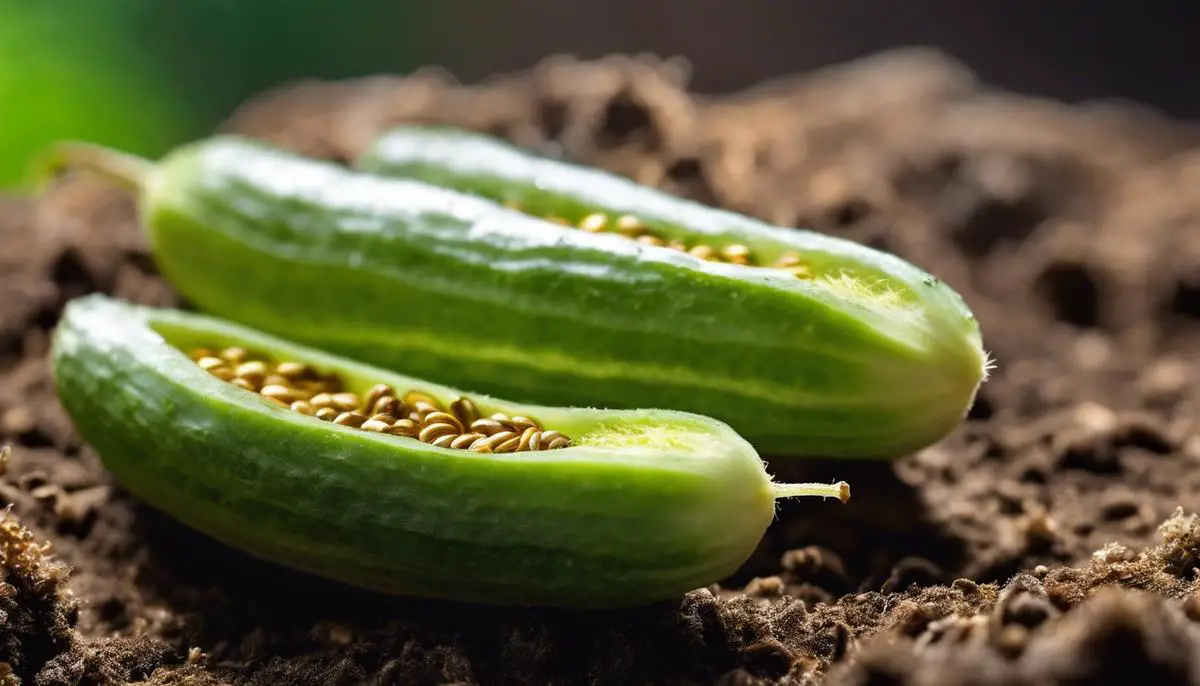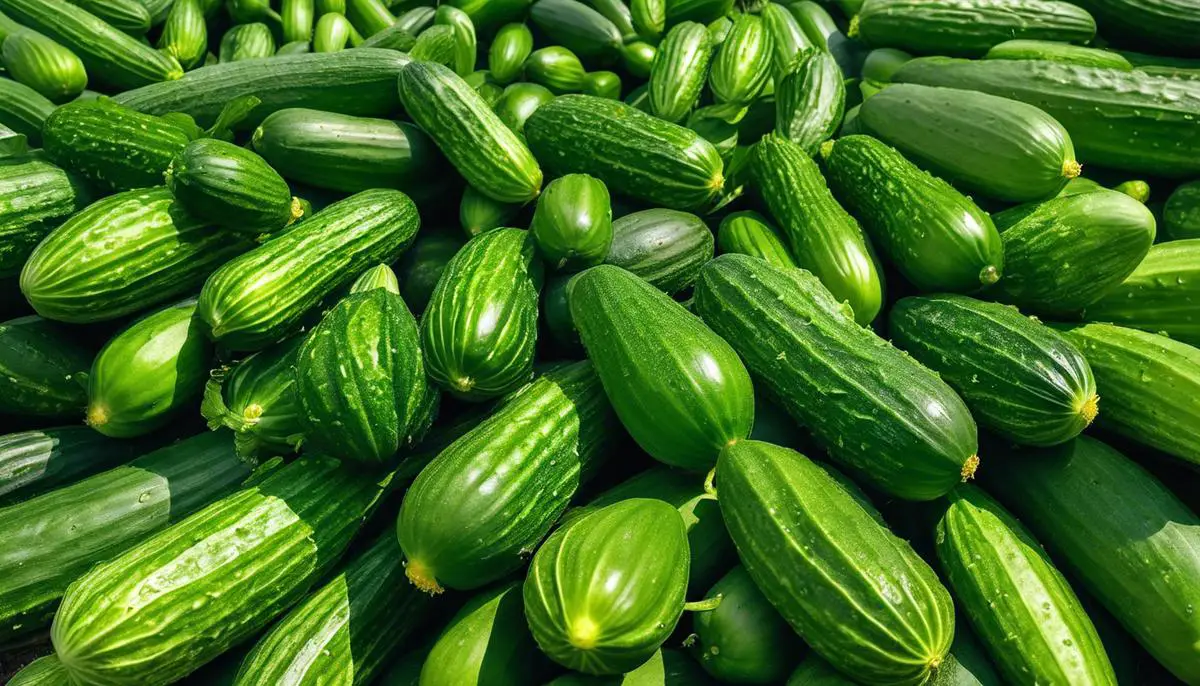Cucumbers are famously known for their crunchy texture and refreshing flavor, a star ingredient in salads and other dishes. No wonder many gardening enthusiasts choose to plant cucumbers in their gardens. Growing cucumbers, however, requires knowledge, not only of the seed germination process and conditions required for this miracle of nature to happen but also of the preparatory steps necessary for planting, caring, and eventually transplanting the seedlings. This guide will delve deep into these topics, aiming to provide comprehensive insights into the journey from a tiny cucumber seed to a thriving, fruit-bearing plant.
Understanding the Cucumber Seed Germination Process
Discover the Magic: How do Cucumber Seeds Germinate?
Are you a fellow gardening enthusiast looking to unlock the secrets locked inside those tiny cucumber seeds? If yes, then you’ve landed on the right page. Here, we’ll immerse ourselves in the magical journey of cucumber seed germination and explore the process in a step-by-step, easy-to-understand manner.
Reader Poll: What online courses would interest you?
Things begin under the surface, concealed from the naked eye. The moment that glossy cucumber seed is gently pushed into the warm, welcoming soil, the germination process kicks into high gear.
First and foremost, cucumber seeds require precise conditions to germinate. The soil, kept consistently moist but never waterlogged, goes a long way in encouraging germination. Ideal soil temperatures range between 70 and 85 degrees Fahrenheit. Lower temperatures can slow down the growth rate, while higher ones can cause harm to the seed.
Once these conditions are met, the seed begins to absorb water. This stage, scientifically known as imbibition, swells the seed and kick-starts the germination process. Here, the seed begins to reactivate the essential enzymes locked within, setting in motion the biological processes necessary for the growth of the plant.
Subscribe to our newsletter!
As the seed imbibes water, the seed coat softens and splits open. This allows the radical (the precursor of the root system) to emerge. It grows downwards, anchoring the plant to the soil.
Meanwhile, the shoot (the future plant part above the ground) begins to grow upwards. This part of the germination process is known as emergence. The iconic, loop-like structure that can be seen at this stage is called the hypocotyl arch. This arch later straightens, pulling the seed leaves (cotyledons) and the rest of the plant upward to break the surface of the soil.
Photosynthesis kicks off when the seedling emerges, making its debut appearance above the soil. The cotyledons, an integral part of the germination process, serve as an energy source until photosynthesis starts taking place in the actual leaf of the plant.
Lastl
y, the first set of true leaves, which resemble those of an adult plant, make their appearance. The seedling then continues to grow, mature, and before you know it, you’ve got an entire plant ready to provide you with delicious, crunchy cucumbers.All in all, cucumber seed germination is a beautiful sight to behold, a testament to the wonders of nature, packed into tiny shells of potential. With patience, careful attention, and a keen gardener’s eye, the cucumber seed germination process can be observed, appreciated, and cherished. So here’s to many successful harvests in your future. Happy gardening!

Preparing the Growing Medium for Cucumber Plants Seed
Crafting the Perfect Growing Medium for Thriving Cucumber Seeds
Cucumber seeds, with their thirst for rich, well-drained soil, necessitate thoughtful preparation of their nurturing medium. Whether from a gardener just dipping a toe into the world of gardening or an experienced green thumb, these seeds demand certain conditions to thrive. Those fresh, crunchy cucumbers you imagine slicing and dicing are just a few steps away in the right growing medium.
Let’s journey together through the crafting process of this winning growth bed.
To start, consider your container. There’s no need for anything fancy; a standard seedling tray or recycled containers such as yogurt pots or egg cartons work excellently if perforated at the bottom. This allows for proper drainage—a vital feature for preventing waterlogging and the damp conditions that invite seed diseases.
Next comes the soil mixture, the soul of your growth medium. Shopify’s base is recommended—a mix of equal parts of garden soil, compost, and sharp sand or perlite. The garden soil and compost provide essential nutrients while the sand or perlite ensures good drainage.
Before you go reaching for that shovel, however, a word of caution: Unless pasteurized, garden soil can harbor diseases and pests that could sabotage your seeds. If using garden soil, it’s worth the extra effort to sterilize it by baking in an oven at 200F for 30 minutes. This heat treatment kills any lurking undesirables and grants your seeds a fresh, clean start.
For those loath to fire up the oven, commercial seed starting mix provides a convenient alternative. These mixes are lightweight, disease-free, and often fortified with a starter charge of slow-release fertilizer to nourish seedlings.
After choosing your soil foundation, it’s time to personalize it with extras. Adding aged compost contributes beneficial microbes and additional nutrients, while a sprinkling of bone meal provides the phosphorous crucial to healthy root development. For those aiming to go the extra mile, sea kelp and worm castings provide additional beneficial nutrients for the young seedlings.
Now, your soil mix is nearly ready. The consistency should be like crumbly chocolate cake—not too wet, but not too dry.
Finally, it’s time for planting. Scatter the cucumber seeds on the surface, cover them with a quarter-inch layer of your soil mixture, and water lightly. One last trick is to cover your seeded container with a clear plastic lid or bag to create a mini greenhouse effect, boosting seed germination.
Nurture these potential cucumber plants by situating the container in a warm, bright spot, keeping the soil slightly moist, and waiting. With patience, love, and this nutrient-packed growing medium, your cucumber seedlings are poised to sprout and flourish into mature plants, eager to reward you with a bountiful harvest.

Planting, Care and Transplanting of Cucumber Seedlings
Achieving a beautiful garden brimming with ripe, juicy cucumbers begins with proper planting and care of cucumber seedlings. By understanding more about the process of planting, caregiving, and transplanting cucumber seedlings, you can better increase the chances of yielding a successful cucumber crop.
Choosing the right container for your cucumber seedlings is crucial. Opt for pots or containers that are around 3 – 4 inches deep and have drainage holes to ensure the seedlings do not become water logged. Too much water can lead to undesirable conditions such as root rot.
Cucumber seeds appreciate good-quality soil with a rich blend of nutrients. Preparing an ideal soil mixture involves richness of organic matter and excellent water retaining capacity mixed with good drainage. A mixture of equal parts sand, garden soil, and compost or peat moss has proven effective for many hobbyists.
To minimize disease transmission and pest attacks, it’s beneficial to sterilize your garden soil. This can be done by baking it in the oven at 200 degrees Fahrenheit for about 20 minutes. Alternatively, consider using sterilized commercial seed-starting mix as this can save time and is readily available.
To enrich your soil, don’t shy away from adding extras such as aged compost, bone meal, sea kelp, and worm castings. These additions pump the soil with nutrients and secure vitality of the cucumber plants.
After ensuring the soil has the right ingredients, focus on achieving a proper consistency. The soil mixture should hold water without becoming oversaturated, producing a moist but crumbly texture.
Planting cucumber seeds isn’t complicated. Make a half-inch hole in the soil, place the seed, and then cover it back up. A rule of thumb is to water generously after planting to encourage speedy and healthy germination.
Creating a mini greenhouse-effect can further enhance the germination process. Covering pots with plastic wrap traps in humidity and heat, which are perfect conditions for germination. But remember, once the seedlings start to sprout, remove the cover to prevent molding or rotting.
Cucumber seedlings need proper care for steady growth. They benefit from six to eight hours of direct sunlight per day, so place them near a south-facing window if possible. Maintaining moisture levels is important as well. Avoid a dry-out but steer clear of overwatering which could lead to a drowned plant. As for temperature, keep it regulated around 70-85 degrees Fahrenheit for optimal growth.
Transferring or transplanting cucumber seedlings is a delicate task. Wait until the second set of “true” leaves appear and the danger of frost has passed. The seedling should be gently removed from the original container, keeping the root system intact. Dig a hole in the desired location that’s deep enough to cover the root ball of the seedlings and place the plant in. Transplanting is an enormous shock to a seedling so water generously afterwards.
And there you have it, a comprehensive guide on getting those cucumber plants all ready for a healthy life, leading to an abundant harvest. Happy Gardening!

Undoubtedly, each stage of the cucumber’s growth journey, from the thrill of germination to the delicate transplanting process, is fraught with challenges yet is rewarding. It requires patience, attention, and a degree of experiential learning. Once familiar with each step’s intricate nuances, anyone can transform their gardening pastime into an enriching activity that results in fresh cucumbers ready for pickling, adding to a salad, or simply eating straight off the vine. Start your cucumber planting journey today and revel in the incomparable joy of watching life grow in your very own garden.

